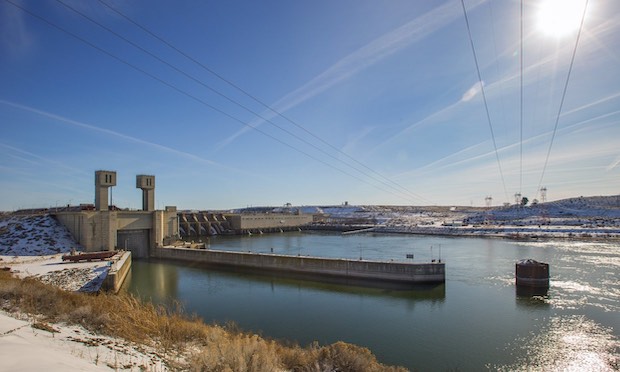forum
library
tutorial
contact

WA's Deadline for No More Fossil Fuel Impossible
If Snake River Dams Breached, Study Says
by Annette Cary
Bellingham Herald, July 5, 2022
|
the film forum library tutorial contact |

|
WA's Deadline for No More Fossil Fuel Impossible
by Annette Cary
|
"The analysis demonstrates that if we are serious about reaching our climate goals,
dams on the lower Snake River must remain operational,"
-- Kurt Miller, executive director of Northwest RiverPartners
The four lower Snake River dams are essential to meeting the Northwest's climate goals to decarbonize the electric grid by 2045, says a new analysis commissioned by Northwest RiverPartners.
The analysis finds that breaching the four dams from Ice Harbor near the Tri-Cities upriver to Lower Granite Dam near Lewiston, Idaho, would require $15 billion to replace energy, but that greenhouse gas emissions still likely would increase.
"The analysis demonstrates that if we are serious about reaching our climate goals, dams on the lower Snake River must remain operational," said Kurt Miller, executive director of Northwest RiverPartners.
The analysis, by Energy GPS Consulting for Northwest RiverPartners, was released less than two weeks before the comment period ends on a draft report commissioned by Washington Gov. Jay Inslee and Sen. Patty Murray, both democrats, which found that breaching the dams was doable.
Murray and Inslee will use the final report to make a recommendation about the future of the dams.
Their study put the cost not just of replacing energy from the hydropower dams and stabilizing the grid, but replacing other benefits, including irrigation and shipping by barge, at $10.3 billion to $27.2 billion, plus possible other as yet unknown costs.
The high end of the estimate is still below a proposal by U.S. Rep. Mike Simpson, R-Idaho, in early 2021 to spend $33.5 billion to replace or mitigate lost benefits of removing the lower Snake River dams. Replacing the energy lost would cost $10 billion, plus $2 billion to optimize the efficiency and resiliency of the electric grid, according to the proposal.
Breaching or tearing down the federal dams has been considered for decades as a way to help endangered salmon, but the proposal is gaining support in Washington, D.C., and in Western Washington.
The June 9 report commissioned by Inslee and Murray concluded that breaching the dams would have the highest likelihood of removing salmon from Endangered Species Act listing and maintain tribal treaty obligations, compared with other proposals. However, it also acknowledged that factors unrelated to the dams have contributed to salmon declines.
The Inslee/Murray report said that the four lower Snake dams have multiple energy benefits, including providing clean energy and stabilizing the electric grid but that they could be replaced by wind and solar electricity production, coupled with energy storage and energy efficiency.
BREACHING DAMS AND CLEAN ENERGY
 But the cost would be high, both in dollars and the clean energy future of the West, according to the report commissioned by Northwest RiverPartners.
But the cost would be high, both in dollars and the clean energy future of the West, according to the report commissioned by Northwest RiverPartners.
The organization is made up of agencies dependent on the dams, including Tri-Cities area utilities such as the Benton and Franklin PUDs and the Benton REA.
Washington state law mandates decarbonizing electrical generation by 2045 and Oregon law requires that goal to be met by 2040, already a herculean task, according to Northwest RiverPartners.
Meeting the clean energy requirements of states in the Western Power Pool Region -- Washington, Oregon, Montana, Idaho, Nevada, Utah, Wyoming, Colorado and part of northern California -- will require an additional 160,000 megawatts of clean power, according to the new report.
That will cost $142 billion for new infrastructure as changes are made to the electricity production mix, such as retiring coal and natural gas plants and adding wind and solar production.
The analysis said that cost estimate could be low because it does not consider factors such as new long-distance, high voltage transmission infrastructure and increased demand as buildings and cars and trucks shift to electric use.
It also does not consider whether enough land will be available for the significant expansion of wind and solar production.
Breaching the dams would require an additional 14,900 megawatts of new generation and batteries, the analysis said.
This is 23% of the Pacific Northwest's current generation capacity and enough to power 15 cities the size of Seattle, according to Northwest RiverPartners.
It attributed the high generation capacity estimate to the need to have power available when demand peaks and the inefficiencies of wind and solar electricity production, which generally produce intermittent power at the same times.
Even if the region doubles its pace of adding renewable energy infrastructure, it is unlikely that state goals can be met until 2076, the analysis concluded.
It would cause emissions in the Pacific Northwest to increase by 145 million tons of carbon dioxide to maintain grid reliability, the analysis said. That includes an additional 5.5 million to 8.4 million tons released into the atmosphere should the four hydroelectric dams be breached, the study said.
"The current risk in not meeting our region's decarbonization goals is high," Miller said. "Removing the Snake River dams increases that risk to the breaking point."
COMMENT ON DAM BREACHING
Online comments on the Inslee/Murray report that concluded breaching the dams is possible, but expensive, can be submitted through the project website: lsrdoptions.org. Emailed comments can be sent to info@lsrdoptions.org with the email subject line "Draft LSRD Benefit Replacement Study."
Comments also may be mailed to Draft LSRD Benefit Replacement Study c/o Ross Strategic, 1325 Fourth Ave., Suite 1600, Seattle, WA 98101.
learn more on topics covered in the film
see the video
read the script
learn the songs
discussion forum
